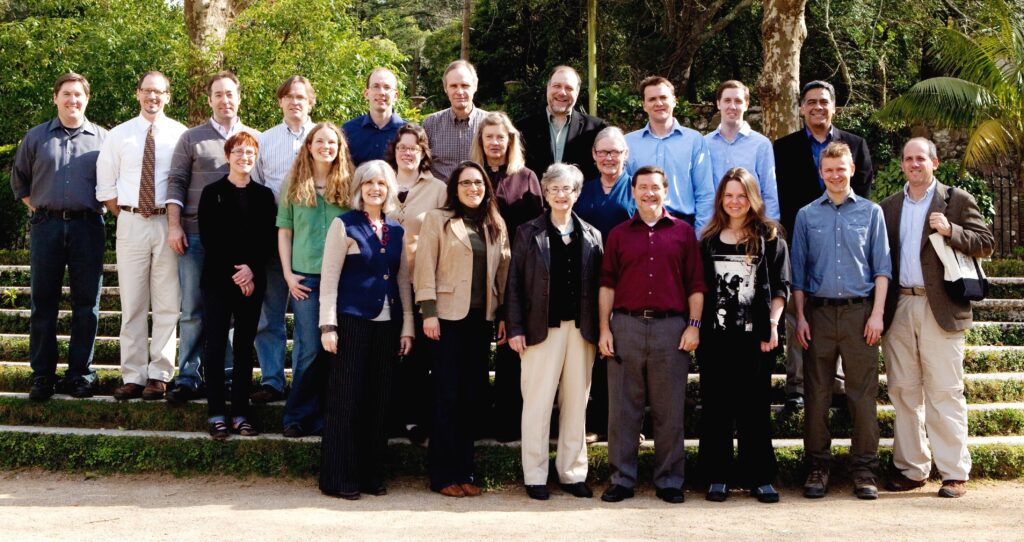Human Biology and the Origins of Homo
Date
Mar 4-11, 2011Organized by
Leslie C. Aiello and Susan AntónLocation
Tivoli Palácio de Seteais Sintra, PortugalPublications
Human Biology and the Origins of Homo, Currently Anthropology, Vol. 53, S6, December 2012.Participants
- Leslie C. Aiello Wenner-Gren Foundation, USA
- Susan Antón New York U., USA
- Richard G. Bribiescas Yale U., USA
- Trenton W. Holliday Tulane U., USA
- Karin Isler U. of Zürich, Switzerland
- Chris Kuzawa Northwestern U., USA
- Katherine C. MacKinnon Saint Louis U., USA
- Andrea B. Migliano U. of Cambridge, UK
- Susan Pfeiffer U. of Toronto, Canada
- J. Michael Plavcan U. of Arkansas, USA
- Herman Pontzer Hunter College, USA
- Rick Potts NMNH, Smithsonian Institution, USA
- Chris Rainwater New York U. and NYCEP, USA
- Tom Schoenemann Indiana U., USA
- Gary T. Schwartz Arizona State U., USA
- Jennifer E. Smith U. of California-Los Angeles, USA
- J. Josh Snodgrass U.of Oregon, USA
- Karen L. Steudel U. of Wisconsin-Madison, USA
- Peter Ungar U. of Arkansas, USA
- Carel van Schaik U. of Zürich, Switzerland
- Jonathan CK Wells U. College London, UK
ORGANIZER’S STATEMENT: In the past decade, new fossil discoveries from East and South Africa, Georgia, and even Indonesia have focused attention on the origins of the genus Homo and the factors that may have lead to its appearance. Indeed, the very definition of the genus has been recently questioned and this discussion seems likely to form a major focus for the next decade of paleoanthropological work. Several morphological differences distinguish early fossil members of the genus Homo from those of Australopithecus and Paranthropus including reduction in tooth and jaw size, reorganization of craniofacial morphology, and changes in body shape and size. And these physical differences have been taken to suggest underlying adaptive shifts at the origin of the genus Homo – most or all of which have energetic and life history implications. Although the majority of these inferences imply energetic, behavioral and life history differences between Australopithecus and early Homo and/or between early Homo and Homo erectus, little time has been spent evaluating the relationships between bodies and behaviors in modern humans in different ecological circumstances.
These are the data that are essential to understand the implications and expectations of anatomical changes at the origin of our genus. Our goal is to bring together human biologists, behaviorists, modelers, and fossil experts to integrate the rich human biological data sets with the new details of the fossil record. The understanding of the adaptive shifts at the origin of Homo are dependent on a solid understanding of the variation within modern humans and particularly on the relationship between human behavior, human bodies, and human lifestyle and life history variation. The goal will be to produce a collection of papers that probe the meaning of the newly identified ranges of variation in size and shape in early Homo based on empirical evidence of how extant humans respond energetically, physiologically, and socially to changes in resource availability and stress, climatic, environmental, and other shifts. We aim to address the relationship between anatomical attributes such as body size and shape, sexual dimorphism, offspring and maternal size, brain size, masticatory morphology and how they are influenced by diet and forage quality, resource stress, climate and thermoregulation, ranging and dispersal, energetics, ontogenetic patterns, behavioral flexibility, group size, cooperation, and parental investment. Our goal is to begin a collaborative process of mining the rich data sets of our subspecialties to forge a stronger and more nuanced understanding of the adaptive shifts that can, or cannot, be inferred at the base of our genus.
We believe that understanding the response of extant humans in marginal and shifting environments provides an ideal basis for understanding the integration of biocultural responses to environmental constraints, and that the applications of these data in light of the known fossil record can help to understand these past populations, their constraints and adaptive strategies. Our assumption is that anatomical changes signal adaptive shifts, and our ultimate goal is to understand these shifts through the identification of ways in which the fossil record can be used to test or assess the predictions made on the basis of inferences rooted in modern human adaptation. In the past two decades our understanding of the origins of the genus Homo has evolved to include the idea of increased diet quality and ranging and increased behavioral flexibility as cornerstones to our evolution. These in turn have led to inferences of enlarging brain and body size, decreases in sexual dimorphism, somewhat expanded ontogenetic periods, increases in energetic requirements, and increased cooperation. Yet recent finds suggest large ranges of size and perhaps shape variation and hint at local adaptation as important yet underappreciated contributors to the morphological picture seen in the fossil record. By bringing together a diverse group of experts in extant and extinct human and nonhuman biology and behavior, we aim to start a lively discussion of the implications of these new conundra.
Current Anthropology supplement on the UCP website
Wenner-Gren Symposium #143
